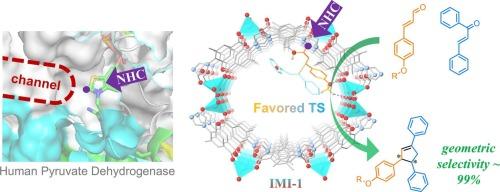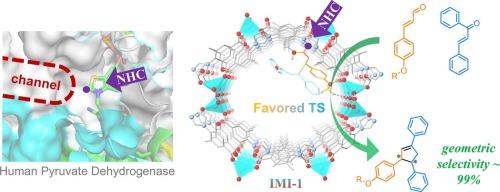Carbene enzyme-inspired confined catalysis in metal-organic framework for enhanced selectivity
IF 6.5
1区 化学
Q2 CHEMISTRY, PHYSICAL
引用次数: 0
Abstract
Developing catalysts with precise micro-environments to regulate catalytic performance has been a continuous endeavor. A carbene enzyme-inspired crystalline porous metal–organic framework (MOF) material incorporating dense and ordered imidazolium cations was synthesized and named IMI-1. In a proper alkaline environment, IMI-1 was found to have dynamic N-heterocyclic carbene (NHC) on its inner pore walls. This catalytic material exhibits potential for various NHC-catalyzed reactions. After applied to annulation reactions between chalcone and 3-aryl acrolein, IMI-1 has shown a notable selectivity with a high diastereomeric ratio up to 139:1 (trans/cis) for p-alkoxylphenyl acrolein, a top-level performance compared to existing literature. Critical transition states that determine reaction selectivity were assessed with semi-empirical computations, and initial findings suggested that a unique micro-environment near the NHC catalytic center is the primary determinant of this enhancement. Similar to natural enzymes, in IMI-1 pores, the Breslow intermediate, a key molecule attached to the pore wall, was uniquely constrained to a conformation that significantly differentiated the energies required for generating different geometric isomers. This regulative capability of IMI-1 has similarities to natural enzymes and could shed some light on the future design of catalysts.


金属-有机骨架中卡宾酶激发的限制性催化增强选择性
开发具有精确微环境的催化剂来调节催化性能一直是人们不断努力的方向。合成了一种含有致密有序咪唑阳离子的碳酶激发结晶多孔金属有机骨架(MOF)材料,命名为IMI-1。在适当的碱性环境下,发现IMI-1的内孔壁上有动态n -杂环碳(NHC)。这种催化材料显示出各种nhc催化反应的潜力。应用于查尔酮与3-芳基丙烯醛之间的环化反应后,IMI-1对对烷氧基苯基丙烯醛表现出了显著的选择性,其非对映比高达139:1(反式/顺式),与现有文献相比具有顶级的选择性。通过半经验计算评估了决定反应选择性的关键过渡态,初步结果表明,NHC催化中心附近的独特微环境是这种增强的主要决定因素。与天然酶类似,在IMI-1孔中,附着在孔壁上的关键分子Breslow中间体被独特地限制在一种构象上,这种构象显著区分了生成不同几何异构体所需的能量。IMI-1的这种调节能力与天然酶有相似之处,可以为未来催化剂的设计提供一些启示。
本文章由计算机程序翻译,如有差异,请以英文原文为准。
求助全文
约1分钟内获得全文
求助全文
来源期刊

Journal of Catalysis
工程技术-工程:化工
CiteScore
12.30
自引率
5.50%
发文量
447
审稿时长
31 days
期刊介绍:
The Journal of Catalysis publishes scholarly articles on both heterogeneous and homogeneous catalysis, covering a wide range of chemical transformations. These include various types of catalysis, such as those mediated by photons, plasmons, and electrons. The focus of the studies is to understand the relationship between catalytic function and the underlying chemical properties of surfaces and metal complexes.
The articles in the journal offer innovative concepts and explore the synthesis and kinetics of inorganic solids and homogeneous complexes. Furthermore, they discuss spectroscopic techniques for characterizing catalysts, investigate the interaction of probes and reacting species with catalysts, and employ theoretical methods.
The research presented in the journal should have direct relevance to the field of catalytic processes, addressing either fundamental aspects or applications of catalysis.
 求助内容:
求助内容: 应助结果提醒方式:
应助结果提醒方式:


